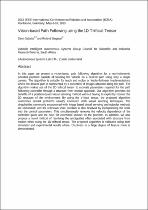JavaScript is disabled for your browser. Some features of this site may not work without it.
- ResearchSpace
- →
- Research Publications/Outputs
- →
- Conference Publications
- →
- View Item
| dc.contributor.author |
Sabatta, D

|
|
| dc.contributor.author |
Siegwart, R

|
|
| dc.date.accessioned | 2013-10-23T12:15:45Z | |
| dc.date.available | 2013-10-23T12:15:45Z | |
| dc.date.issued | 2013-05 | |
| dc.identifier.citation | Sabatta, D and Siegwar,t R. 2013. Vision-based path following using the 1D trifocal tensor. In: 2013 IEEE International Conference on Robotics and Automation (ICRA), Karlsruhe, Germany, 6-10 May 2013 | en_US |
| dc.identifier.isbn | 978-1-4673-5642-8 | |
| dc.identifier.uri | http://hdl.handle.net/10204/7005 | |
| dc.description | 2013 IEEE International Conference on Robotics and Automation (ICRA)Karlsruhe, Germany, May 6-10, 2013. Abstract only attached. | en_US |
| dc.description.abstract | In this paper we present a vision-based path following algorithm for a non-holonomic wheeled platform capable of keeping the vehicle on a desired path using only a single camera. The algorithm is suitable for teach and replay or leader-follower implementations where the desired path is represented by a collection of images obtained along the path. The algorithm makes use of the 1D trifocal tensor to estimate parameters required for the path following controller through a structure from motion approach. Our algorithm provides the benefits of a position-based visual servoing method without having to explicitly recover the 3D structure of the environment. By using the trifocal tensor, the proposed algorithm overcomes several problems usually associated with visual servoing techniques. The singularities commonly encountered with image based visual servoing and epipolar methods are eliminated; and the unknown scale problem is also resolved by incorporating the scale into the control parameters. This simultaneously removes the velocity dependence of the controller gains and the need for odometric sensors on the platform. In addition, we also propose a novel method of resolving the ambiguities often associated with structure from motion when using the 1D trifocal tensor. The proposed algorithm is validated using both simulated and experimental results where robustness to a large degree of feature noise is demonstrated. | en_US |
| dc.language.iso | en | en_US |
| dc.relation.ispartofseries | Workflow;11593 | |
| dc.subject | Robotics | en_US |
| dc.subject | Automation | en_US |
| dc.subject | Algorithms | en_US |
| dc.subject | Autonomous systems | en_US |
| dc.title | Vision-based path following using the 1D trifocal tensor | en_US |
| dc.type | Conference Presentation | en_US |
| dc.identifier.apacitation | Sabatta, D., & Siegwart, R. (2013). Vision-based path following using the 1D trifocal tensor. http://hdl.handle.net/10204/7005 | en_ZA |
| dc.identifier.chicagocitation | Sabatta, D, and R Siegwart. "Vision-based path following using the 1D trifocal tensor." (2013): http://hdl.handle.net/10204/7005 | en_ZA |
| dc.identifier.vancouvercitation | Sabatta D, Siegwart R, Vision-based path following using the 1D trifocal tensor; 2013. http://hdl.handle.net/10204/7005 . | en_ZA |
| dc.identifier.ris | TY - Conference Presentation AU - Sabatta, D AU - Siegwart, R AB - In this paper we present a vision-based path following algorithm for a non-holonomic wheeled platform capable of keeping the vehicle on a desired path using only a single camera. The algorithm is suitable for teach and replay or leader-follower implementations where the desired path is represented by a collection of images obtained along the path. The algorithm makes use of the 1D trifocal tensor to estimate parameters required for the path following controller through a structure from motion approach. Our algorithm provides the benefits of a position-based visual servoing method without having to explicitly recover the 3D structure of the environment. By using the trifocal tensor, the proposed algorithm overcomes several problems usually associated with visual servoing techniques. The singularities commonly encountered with image based visual servoing and epipolar methods are eliminated; and the unknown scale problem is also resolved by incorporating the scale into the control parameters. This simultaneously removes the velocity dependence of the controller gains and the need for odometric sensors on the platform. In addition, we also propose a novel method of resolving the ambiguities often associated with structure from motion when using the 1D trifocal tensor. The proposed algorithm is validated using both simulated and experimental results where robustness to a large degree of feature noise is demonstrated. DA - 2013-05 DB - ResearchSpace DP - CSIR KW - Robotics KW - Automation KW - Algorithms KW - Autonomous systems LK - https://researchspace.csir.co.za PY - 2013 SM - 978-1-4673-5642-8 T1 - Vision-based path following using the 1D trifocal tensor TI - Vision-based path following using the 1D trifocal tensor UR - http://hdl.handle.net/10204/7005 ER - | en_ZA |






